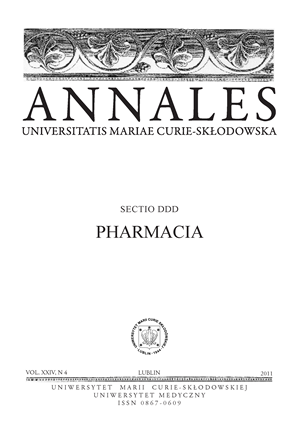Screening of antifungal activity of Rumex L. species
DOI:
https://doi.org/10.12923/Keywords:
Rumex L., ethanol extracts, fruits, leaves, roots, antifungal activityAbstract
Antifungal activity of the ethanol extracts obtained from fruits, leaves and roots of six species of Rumex L. (R. acetosa L., R. acetosella L., R. confertus Willd., R. crispus L., R. hydrolapathum Huds. and R. obtusifolius L.) growing in Poland against the reference strains yeasts, dermatophytes and moulds was assessed by agar dilution method allowing for determination of minimal inhibitory concentration (MIC). The extracts from fruits of R. confertus, R. crispus, R. hydrolapathum and R. obtusifolius were the most active, showing moderate activity against Candida spp. and Trichophyton mentagrophytes ATCC 9533 with MIC = 250-500 μg/mL; no activity against Aspergillus niger ATCC 16404 was found. The obtained data indicate the fruits from the above Rumex species may be regarded as alternative or adjunctive agents in treatment of superficial mycoses.
References
1. Babulka P: Les rumex, de l’ethnobotanique á la phytothérapie moderne (Rumex spp.). Phytothérapie, 5, 153, 2004.
2. Borchardt JR et al.: Antioxidant and antimicrobial activity of seed from plants of the Mississippi river basin. J. Med. Plant. Res., 3, 707, 2009.
3. Bruni A, Ballero M, Poli F: Quantitative ethnopharmacological study of the Campidano Valley and Urzulei district, Sardinia, Italy. J. Ethnopharmacol., 57, 97, 1997.
4. Elegami AA et al.: Sudanese plants used in folkloric medicine: screening for antibacterial activity. Part X. Fitoterapia, 72, 810, 2001.
5. Getie M et al.: Evaluation of the anti-microbial and anti-inflammatory activities of the medicinal plants Dodonaea viscosa, Rumex nervosus and Rumex abyssinicus. Fitoterapia, 74, 139, 2003.
6. Gosh L et al.: Antibacterial efficacy of Rumex nepalensis Spreng. roots. Phytother. Res., 17, 558, 2003.
7. Groll AH, Walsh TJ: Uncommon opportunistic fungi: new nosocomial threats. Clin. Microbiol. Infect., 7, 8, 2001.
8. He L-Y, Bi-Zhu Ch, Pei-Gen X: Survey, identification and constituent analysis of Chinese herbal medicines from the genus Rumex. XaoHsueh Pao, 16, 289, 1981.
9. Jaroniewski W: Szczaw lancetowaty – wartościowa roślina lecznicza. Wiad. Ziel., 6, 12, 1992. (in Polish)
10. Merzouki A, Ed-derfoufi F, Mesa JM: Contribution to the knowledge of Rifian traditional medicine. II: Folk medicine in Ksar Lakbir district (NW Morocco). Fitoterapia, 71, 278, 2000.
11. Ozturk S, Ozturk A: Antibacterial activity of aqueous and methanol extracts of Rumex alpinus and Rumex caucasicus. Pharm. Biol., 45, 83, 2007.
12. Pappas PG et al.: A prospective observational study of candidemia: epidemiology, therapy, and influences on mortality in hospitalized adult and pediatric patients. Clin. Infect. Dis., 37, 634, 2003.
13. Pfaller MA, Diekema DJ: Epidemiology of invasive candidiasis: a persistent public health problem. Clin. Microbiol. Rev., 20, 133, 2007.
14. Pieroni A: Medicinal plants and food medicines in the folk traditions of the upper Lucca Province, Italy. J. Ethnopharmacol., 70, 235, 2000.
15. Shale TL, Stirk WA, van Staden J: Screening of medicinal plants used in Lesotho for anti-bacterial and anti-inflammatory activity. J. Ethnopharmacol., 67, 347,1999.
16. Taylor RSL et al.: Antimicrobial activities of southern Nepalese medicinal plants. J. Ethnopharmacol., 50, 97, 1996.
17. Ulukanli Z et al.: Antimicrobial activities of some plants from the Eastern Antolia region of Turkey. Pharm. Biol., 43, 334, 2005.
18. Warnock DW: Trends in the epidemiology of invasive fungal infections. Jpn. J. Med. Mycol., 48, 1, 2007.
19. Wegiera M et al.: Antibacterial activities of the leaves from the selected species of Rumex L. genus. Annales UMCS, Sec. DDD., 2, 161, 2006.
20. Yeşilada E et al.: Traditional medicine in Turkey IX: Folk medicine in north-west Anatolia. J. Ethnopharmacol., 64, 195, 1999.
21. Yildirim A, Mavi A, Kara AA: Determination of antioxidant and antimicrobial activities of Rumex crispus L. extracts. J. Agric. Food Chem., 49, 4083, 2001.
Downloads
Published
Issue
Section
License
Copyright (c) 2011 Authors

This work is licensed under a Creative Commons Attribution-NonCommercial-NoDerivatives 3.0 Unported License.


